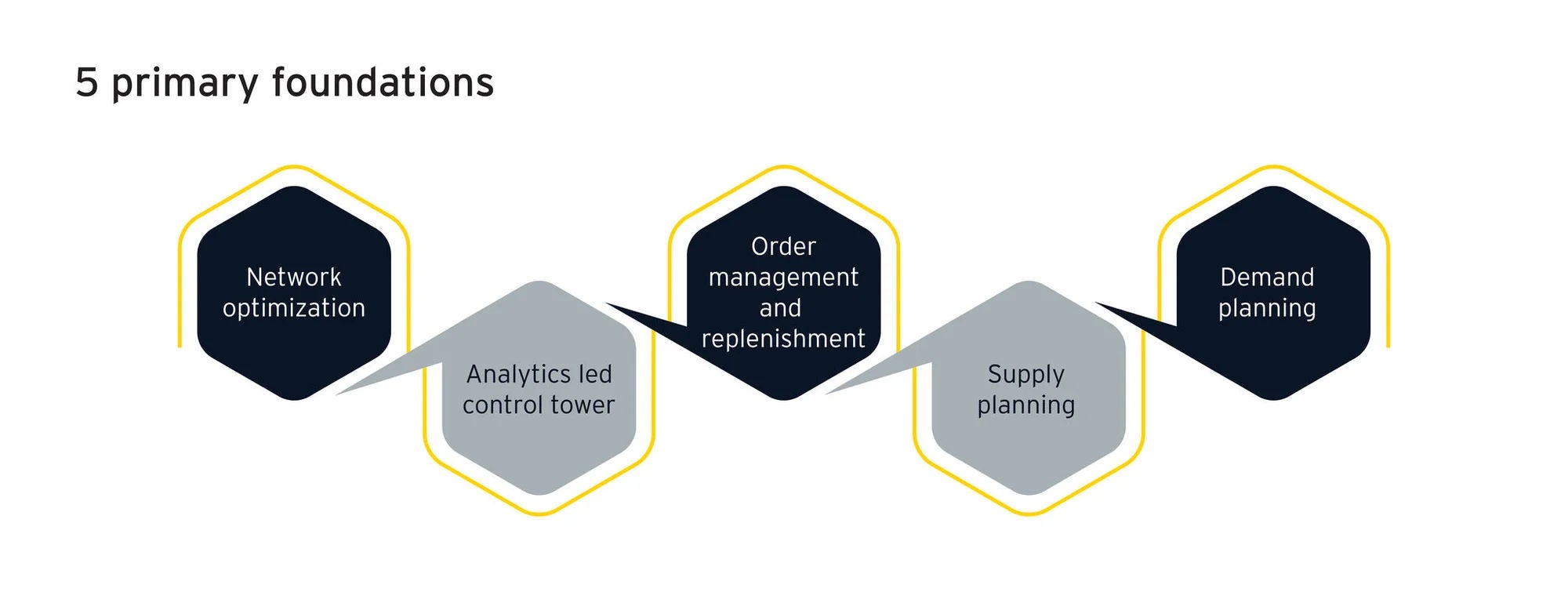EY refers to the global organization, and may refer to one or more, of the member firms of Ernst & Young Global Limited, each of which is a separate legal entity. Ernst & Young Global Limited, a UK company limited by guarantee, does not provide services to clients.
How LT Foods achieved 2x revenue growth with digital supply chain transformation
Reinventing its supply chain and operations, the company leveraged the AI-powered Asterisk platform from EY to achieve growth.
Recognizing that agility and responsiveness are critical to meet evolving consumer expectations, LT Foods India embarked on a mission to reimagine and optimize their end-to-end supply chain, strengthening their business operations for sustained growth. Deploying the Asterisk’s digital supply chain capabilities, LT Foods achieved nearly two times revenue growth, reduced finished good inventory from 45 days to 20 days while expanding their distribution network from six to 12 depots to achieve ~95% service level.
We have almost doubled our revenue since the project’s deployment because of data transformation, enhanced transparency, reduced stockouts, and better representation of depots, which have positively impacted our customers, retailers, and distributors
The 70-year-old company in the packaged food business, specializing in basmati and other rice-based products, has a vast portfolio and is available in more than 80 countries. Supported by a robust network of over 1,300 distributors, LT Foods continues to expand its global footprint into new markets.
However, the company faced several pressing challenges across its supply chain, including delays in deliveries and frequent stockouts, which directly impacted customer satisfaction and business growth. Manual supply planning on Excel resulted in inefficiencies and a limited ability to adapt swiftly to market demands. Moreover, order prioritization needed a strong, systematic approach, as it often relied on individual intuition rather than being guided by data-driven insights.
To support its growth ambitions and respond to the demands of a rapidly changing market, LT Foods recognized the need for a dynamic, agile and adaptive supply chain strategy. In 2020, LT Foods commenced its supply chain transformation journey with EY. The primary focus was to enable business growth and expansion across domestic and global markets. The EY Asterisk digital platform was selected by LT Foods to drive the transformation and unlock value, offering agility to meet LT Foods’ unique needs.
Together with LT Foods, EY conducted co-collaborative workshops to design an end to end planning system and successfully transform the supply chain. The foundation of this transformation in the supply chain strategy was set on five pillars.
1. Analytics-led control tower: Analytics-led control tower improved supply chain visibility and transparency by providing daily insights and actionable recommendations. The dashboards, spanning sales, supply chain, manufacturing, and procurement, made key metrics accessible. Reports for root cause analysis further streamlined the journey, making conversations between teams more data-driven and concrete, one of the biggest takeaways for the organization. This single version of the truth fostered collaboration and growth.
2. Order management and replenishment: The company transitioned to an end-to-end replenishment model, reducing lead times, improving range availability, and enhancing customer service levels by implementing scientific inventory norms. This enabled improved response to customer orders while eliminating slow-moving inventory.
3. Supply planning: Planning agility extended to production through automated daily refreshed production plans. EY designed frozen, fixed and tentative planning horizons to respond to market demands while maintaining stability across manufacturing. LT Foods produced a higher range of SKUs per day and increased its capability and efficiency for daily changeovers.
4. Demand planning: Using Asterisk’s AI-powered demand planning engine, LT Foods integrated statistical forecasting capability to strengthen the demand collaboration process. EY promoted bottom-up collaboration planning across the sales team, supported by marketing and product owners, thereby improving ownership, efficiency and plan accuracy.
5. Network optimization: Through optimization modeling, the depot network was redesigned, which included resizing, closing and opening new depots. LT Foods expanded its network from six to 12 depots, enhanced customer service, reduced delivery lead times and optimized delivery costs.
The customer-centric supply chain design and deployment enabled LT Foods to become agile and responsive to market dynamics while delivering service levels upwards of 95%.


The Asterisk Platform underpinned the pivotal shift at LT Foods, with agility and responsiveness at the heart of the transformation. Leadership at LT Foods facilitated the transition, promoting teamwork, and adopting the reimagined operating model. The Asterisk platform acted as the change accelerator, leading LT Foods towards sustainable business expansion.
The digital supply chain transformation journey of LT Foods India exemplifies resilience, foresight, and innovation. As the improvements achieved were not just technological; they reflected a cultural shift within the organization. The team across sales, plants and supply chain functions became more agile, adapting seamlessly to business changes. Today, they embrace this new approach with confidence and enthusiasm, making it an integral part of their daily operations.
Success mantra
- Establish KPIs and well-defined expectations to maintain agility and to re-engineer the supply chain processes.
- Focus on building people’s capability to drive sustainable business growth.
- Create a culture of data led metrics for continuous improvement and collaboration.
- Invest in advanced technologies for real-time data insights and analytics as it is vital for informed decision-making.
How EY can help
-
Supply chain consulting services & solutions at EY helps optimizing supply chain management and operations, boosting agility, efficiency, and resilience
Read more -
Optimize your supply chain management with EY Asterisk Digital Platform, featuring advanced solutions designed for efficiency, scalability & sustainable growth.
Read more -
Explore Digital Transformation Services at EY, helping businesses innovate, manage risks, seize opportunities & drive sustainable growth with IT solutions.
Read more
Related Content
How Dabur is on a transformation journey to embed long term value for its stakeholders
Dabur embarks on a sustainable transformation, targeting net-zero carbon by 2045 and water positivity by 2030, embedding ESG for stakeholder value.
How a manufacturer eliminates cost and value leakages with AI-ML
Discover how EY AI-enabled tool helps a roofing solutions manufacturer improve production efficiency while maintaining quality standards. Learn more about AI in manufacturing use case.
How a young cement company grew 2.5x with organizational and functional transformation
Learn how EY helped a young cement manufacturer grew production capacity by 2.5x facilitated by data-driven transformation.
Summary
LT Foods India embarked on a supply chain transformation journey to address challenges like delivery delays, stockouts, and inefficiencies from manual planning processes. They transformed their supply chain with the AI enabled EY Asterisk SC Platform to become agile, responsive and enable data led analytics and decision making. The transformation led to significant improvements: nearly two-fold revenue growth while maintaining service levels upwards of 95%, reduction in finished goods inventory from 45 days to 20 days. This success was driven by a combination of technology, cultural alignment, and a collaborative approach across all functions, making LT Foods’ future ready to cater to evolving market demands.







